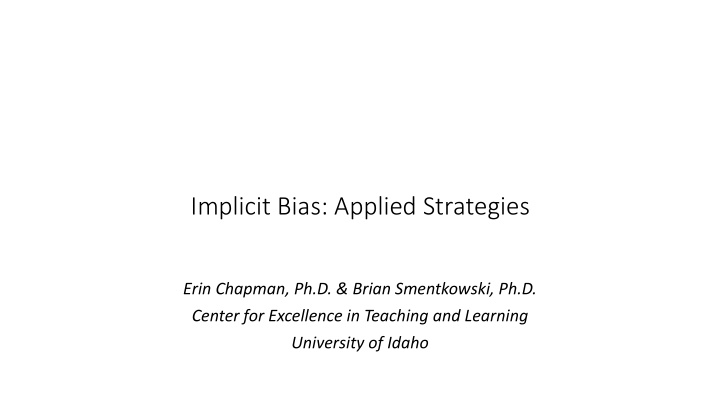



Implicit Bias: Applied Strategies Erin Chapman, Ph.D. & Brian Smentkowski, Ph.D. Center for Excellence in Teaching and Learning University of Idaho
Welcome & Introductions Who are you and why are you here?
Implicit Bias
Mind the Gap: Misconceptions, Misinformation, Ignorance & Stereotypes • https://undsci.berkeley.edu/teaching/misconceptions.php
In the context of our classes & campus community, implicit/unconscious biases and misinformation can result in intolerance, incivility & marginalization
Reality 101 • Implicit Bias is real and we all have our biases • Are you aware of yours? • https://implicit.harvard.edu/implicit/selectatest.html • What can we do about it? • For ourselves and when we witness it among students & peers • Misinformation and lack of perspective have consequences • Conflict & Incivility does occur • What do we do?
Case Studies
Case Study #1 • Questioned authority What do you do? • A post-doc and a tenured faculty are co-teaching a course • During an in-class exam, a student raises her hand to ask a question • The post-doc walks over to offer assistance • The student then asks the post-doc if she could send over the professor to help • Why might a student ask this??
Case Study #2 Implicit Bias and operative assumptions What does this tell us? What do you do? • During a class discussion on immigration, students are asked to develop and present their thoughts on the topic. • When the floor is open for discussion, a student overgeneralizes about who is crossing which border and why. • You notice some of the students becoming agitated by his statements, and one challenges him • His response is “that’s what I think” and to her counterargument, simply replies “that’s your opinion. You have your opinion, I have mine.” • What do you do?
Case Study #3 Create / share your own case What do you do?
Strategies
How do we address our own bias? • Recognize that, as human beings, our brains make assumptions without us even knowing it. • Micro-affirmations • “Micro -affirmations are tiny acts of opening doors to opportunity, gestures of inclusion and caring, and graceful acts of listening” (Scully, Maureen & Mary Rowe, 2009) • Open doors to opportunity - power sharing vs. power hoarding • Gestures of inclusion • Intentional acts of listening
What You Can Do As someone experiencing implicit bias: • Set firm boundaries and be consistent from the beginning • Class/workplace experiential activities • Group readings/trainings • Talk with your supervisor and establish their support • Seek out allies • Keep records of the behavior • In the moment … . • Techniques that have worked for you?
What You Can Do • Increase your personal strength by: • Reminding yourself about your value • Self-advocacy (if possible!) • Practicing self-care (self-preservation) • Thinking about the “bigger fish you have to fry” by putting this interaction into the broader context of your life goals • Practice gratitude • Increase your social resources by: • Participating in mentoring programs • Building your network of mentors (multiple)
What You Can Do As a supervisor or colleague (positions of power!): • Implicit bias is REAL. Believe people and listen when they say they’re experiencing it. • Be mindful of your first impressions of others. If they are negative, ask yourself why. • Encourage and foster equal participation and opportunity. • Recognize the power of images and symbols. • When you recognize your own or others’ bias, name it. Take action. • Other suggestions?
Interrupting Oppressive Behavior: An Action Continuum • What happens when you encounter Microaggressions? • Do you have a plan for what you might do or say? • Whenever you experience oppressive behavior, you can choose your reaction from a range of possible responses:
When the temperature ris ises: Open The Front Door • O = Observe • A concrete, factual observation • T = Think • Thoughts based on observations, but not intended to put the other person on the defensive • F = Feel • Emotions you or others may have as a result of what you observed/conflict • D = Desire • Desired outcome (with gratitude to Dr. Souza)
How it Works: A Scenario • Own it: • I observed • I think • I feel • I desire • As a professor: Pause the class and... • Point out what you noticed (rolling eyes, arms folding, etc). O • Indicate what this makes you think (that you said something contentious that might need to be discussed further). T • Indicate the reason why (some students may feel left out, uncomfortable, etc. You may feel misunderstood. You may think some of them might feel misunderstood). F • Indicate what you desire (someone giving voice to their gestures, a civil conversation on the topic). D • You are modeling the process in real time
Behavioral Responses/Conditioning • Don’t (just) be a first responder – look for flashpoints: • Looks of disbelief • Looks of disengagement • Looks of anger/agitation • Knowing “that student” is going to say *something* • Intervene – how, when? • Do you ever need to “shut it down”? • Pause with intentionality. • Listen with intentionality. • Reframe the topic and the rules for engagement • For example, 1. Use timed intervals for students to think, reflect, write, and share 2. Have them explore the issue from “the other side” 3. Treat all sides fairly 4. State and work towards a goal, conclusion, or solution 5. Conclude the session with your own words, assessing the situation and how they handled it.
Resources • Intercultural Competence Self Evaluation Form • http://www.crlt.umich.edu/sites/default/files/resource_files/InterculturalKnowledge VALUErubric.pdf • https://idiinventory.com/publications/the-intercultural-development-inventory-idi/ • https://www.aacu.org/sites/default/files/files/AM17/Cartwright%20Handout%202.p df • http://rapworkers.com/wp-content/uploads/2017/08/cultural-competence- selfassessment-checklist-1.pdf • On a solution from Communication: • https://www.insidehighered.com/news/2017/03/14/communication-professor- establishes-rules-his-students-talking-about-trump-class • On understanding student and faculty incivility in higher education: • http://www.uncw.edu/jet/articles/Vol12_1/Knepp.html
Recommend
More recommend